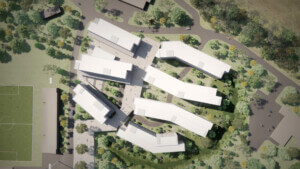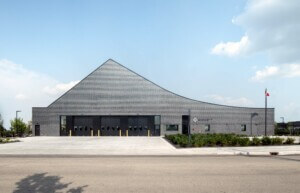| Brought to you by: |
A motorized green wall that reads the weather and adjusts automatically
Two years ago six students and three faculty from Virginia Tech’s School of Architecture + Design spent three weeks at SOM‘s Chicago office applying industrial fabrication solutions to the problem of high density housing for Southworks, a housing development that’s currently being planned for a large vacant section south of the city. The result was LumenHAUS, an aggressively energy efficient home that won the international Solar Decathlon Competition that June for sustainable solutions to high density construction. LumenHAUS is not only net zero, it actually creates more energy than it uses by implementing, among other innovations, a modular system that autonomously responds to external weather information and internal environmental conditions to optimize energy use. This Fall Virginia Tech’s Center for Design Research will begin construction on a full scale prototype of six housing modules, including a working prototype of Hanging Garden, a dynamic plant wall that reads the weather and responds by sliding along the walls and windows to either block or allow sunlight into the living unit.
Hanging Garden combines automated shading control with the emerging demand for urban garden space. Each unit is composed of a series of planters and and can be configured into one of three scenarios: (1) fully nested against the side walls of the south facing projecting balcony, (2) partially deployed to protect the balcony from east or west light or wind or (3) fully deployed and aligned with the outer face of the balcony (rotated 90 degrees). Each unit can automatically adjust to accommodate changing weather patterns, plant type and user demands by means of an actuated track system provided by Hafele. Two ceiling mounted tracks run parallel to each other until the garden reaches the outer balcony. At this point the slave trolley follows the radial track and sends the garden plane horizontally along the outer edge of the balcony.
“The plant wall system is integrated into our ‘responsive architecture’ smart home building control system, which was developed for the LumenHAUS,” said Virginia Tech faculty member Joe Wheeler. “With real time data from both the house-mounted weather station and from interior environment sensors, the computer can detect when shading is needed or when direct solar gain is needed. For example, on a summer day when the system is in cooling mode, exterior temperatures are high and the daylight sensors detect full sun, plant walls are deployed into the full shade position along electronically controlled motorized tracks.”
The Hanging Garden system can be built into a larger outdoor garden patio configuration that allots two outdoor spaces on either end of the main living module. During warmer months the patio can be opened up completely, providing cross ventilation. In colder months they can be closed to act like greenhouses and serve as insulating buffers to the indoor space, becoming passive mechanisms of energy efficiency.
Even those whose thumbs are anything but green can easily keep their Hanging Garden growing year-round, thanks to the self-watering system – also a great feature for when you’re out of town. “When the plant walls are in their “home” position, a reservoir is refilled by a ceiling mounted valve,” Wheeler explained. “The reservoir directs water to each individual pot on the wall and a floor drain in the balcony collects any overflow.” The final product will have a CNC cut steel frame and slip cast ceramic pots, but the prototypes for the six modular units will be made from MDF, an odd choice for such an environmentally progressive project, though perhaps the longterm benefits of Hanging Garden, and of the Southworks complex in general will ultimately outweigh a few preliminary MDF models?










